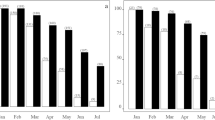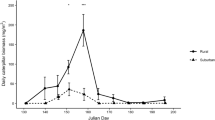Abstract
IN a small proportion of bird species (<3%), offspring delay their dispersal beyond the time when they are reproductively capable, remain on their natal territory, and usually assist the resident breeders, normally their parents, to raise other young1–3. This pattern of social organization and care-giving behaviour, most frequently termed cooperative breeding, is controversial with respect to why offspring delay their dispersal2–8. In this study we investigate the interaction between habitat limitation, habitat quality, and sex ratio in influencing dispersal decisions in a population of superb fairy-wrens (Malurus cyaneus). We show that every non-breeding male (31 of 32; 96.9%) given the opportunity, dispersed and bred. The sex ratio was male-biased and although males did not disperse into vacant but previously occupied territories in the absence of females, the reintroduction of females prompted dispersals. Our data suggest that young males delay their dispersal in response to a limited number of mates and secondarily to habitat limitation.
This is a preview of subscription content, access via your institution
Access options
Similar content being viewed by others
References
Skutch, A. F. Auk 52, 257–273 (1935).
Emlen, S. T. in Behavioural Ecology: An Evolutionary Approach (eds Krebs, J. R. & Davies, N. B.) 305–339 (Sinauer, Sunderland, 1984).
Brown, J. L. Helping and Communal Breeding in Birds: Ecology and Evolution (Princeton University, Princeton, 1987).
Brown, J. L. Am. Zool. 14, 63–80 (1974).
Koenig, W. D. & Pitelka, F. A. in Natural Selection and Social Behavior: Recent Research and New Theory (eds Alexander, R. D. & Tinkle, D. W.) 261–280 (Chiron, New York, 1981).
Emlen, S. T. Am. Nat. 119, 29–39 (1982).
Stacey, P. B. & Ligon, J. D. Am. Nat. 130, 654–676 (1987).
Stacey, P. B. & Ligon, J. D. Am. Nat. (in the press).
Schodde, R. The Fairy-Wrens (Lansdowne, Melbourne, 1982).
Rowley, I. Emu 64, 251–297 (1965).
Brooker, M. G., Rowley, I., Adams, M. & Baverstock, P. R. Behavl Ecol. Sociobiol. 26, 191–200 (1990).
Nias, R. C. Emu 84, 178–180 (1984).
Selander, R. K. Univ. Calif. Publ. Zool. 74, 1–224 (1964).
Author information
Authors and Affiliations
Rights and permissions
About this article
Cite this article
Pruett-Jones, S., Lewis, M. Sex ratio and habitat limitation promote delayed dispersal in superb fairy-wrens. Nature 348, 541–542 (1990). https://doi.org/10.1038/348541a0
Received:
Accepted:
Issue Date:
DOI: https://doi.org/10.1038/348541a0
This article is cited by
-
Annual fitness costs may be balanced by a conservative life history strategy in groups of unrelated ant queens
Behavioral Ecology and Sociobiology (2023)
-
Urban life promotes delayed dispersal and family living in a non-social bird species
Scientific Reports (2021)
-
Communal roosting shows dynamics predicted by direct and indirect nepotism in chestnut-crowned babblers
Behavioral Ecology and Sociobiology (2021)
-
Limited dispersal by large juvenile males leads to kin-structured neighborhoods in the black-crested titmouse (Baeolophus atricristatus)
Behavioral Ecology and Sociobiology (2020)
-
Environmental mismatch results in emergence of cooperative behavior in a passerine bird
Evolutionary Ecology (2018)
Comments
By submitting a comment you agree to abide by our Terms and Community Guidelines. If you find something abusive or that does not comply with our terms or guidelines please flag it as inappropriate.



